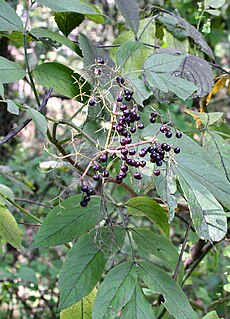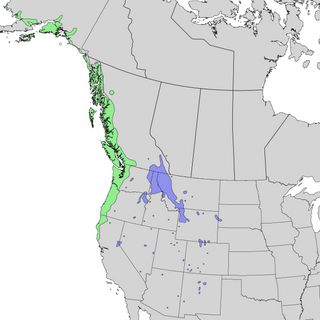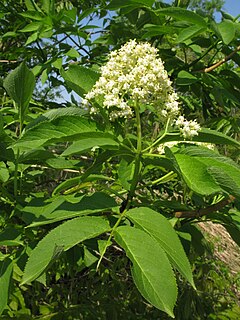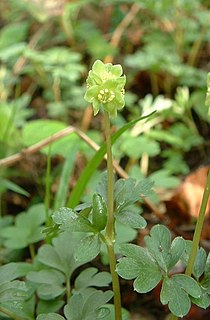
Sambucus is a genus of flowering plants in the family Adoxaceae. The various species are commonly called elder or elderberry. The genus was formerly placed in the honeysuckle family, Caprifoliaceae, but was reclassified as Adoxaceae due to genetic and morphological comparisons to plants in the genus Adoxa.

Sambucus ebulus, also known as danewort, dane weed, danesblood, dwarf elder or European dwarf elder, walewort, dwarf elderberry, elderwort and blood hilder, is a herbaceous species of elder, native to southern and central Europe and southwest Asia. The species is also reportedly naturalized in parts of North America.

Sambucus canadensis, the American black elderberry, Canada elderberry, or common elderberry, is a species of elderberry native to a large area of North America east of the Rocky Mountains, and south through eastern Mexico and Central America to Panama. It grows in a variety of conditions including both wet and dry soils, primarily in sunny locations.

Sambucus nigra is a species complex of flowering plants in the family Adoxaceae native to most of Europe and North America. Common names include elder, elderberry, black elder, European elder, European elderberry, and European black elderberry. It grows in a variety of conditions including both wet and dry fertile soils, primarily in sunny locations. Elder is cited as a poisonous plant for mammals, and as a weed in certain habitats.

Sambucus racemosa subsp. racemosa is a subspecies of Sambucus racemosa, with the common names European red elder and Pacific red elderberry.

János Zsámboky or János Zsámboki or János Sámboki, was a Hungarian humanist scholar: physician, philologist and historian.

Sambucus racemosa is a species of elderberry known by the common names red elderberry and red-berried elder.
The Roman Catholic Archdiocese of Palmas is an archdiocese located in the city of Palmas in Brazil.

Sambucus gaudichaudiana, the white elderberry, is an understorey shrub native to coastal rainforest and cool forests of eastern and south-eastern Australia.

The National Botanic Garden of Bangladesh and the Bangladesh National Herbarium make up the largest plant conservation center in Bangladesh, with an area of around 84 hectares. It is located at Mirpur in Dhaka, beside the Dhaka Zoo. It was established in 1961. It is one of the greatest botanic gardens of Bangladesh, a knowledge center for nature lovers and botanists and a tourist destination. The herbarium has a scientific collection of approximately 100,000 preserved specimens of plants.
Sambucus mexicana may refer to the following North American black or blue elderberry species:

Coniferous swamps are forested wetlands in which the dominant trees are lowland conifers such as northern white cedar. The soil in these swamp areas is typically saturated for most of the growing season and is occasionally inundated by seasonal storms or by winter snow melt.

Sambucus cerulea or Sambucus nigra ssp. cerulea, with the common names blue elderberry and blue elder, is a coarse textured shrub species of elder in the family Adoxaceae.

Sambucus javanica, the Chinese elder, is a species of elderberry in the family Adoxaceae native to subtropical and tropical Asia. It is found naturally in Bhutan, Burma, Cambodia, China, India, Indonesia, Japan, Laos, Malaysia, the Philippines, southern Thailand, and Vietnam. It is a perennial herb or a small shrub 1–2 m tall.
Sambucus velutina, the velvet elder, is a relatively large, deciduous shrub that is endemic to the Southwestern region of the United States. This particular species is characteristic of Central California and Western Nevada.
Chrysotoxum festivum is a species of hoverfly which inhabits clearings within scrub woodland and deciduous forest ranging from Fernoscandia to Northern Africa.

Sambucus sieboldiana, commonly called the Japanese red elder, is a deciduous shrub in the moschatel family (Adoxaceae). It is native to East Asia, where it is found in Japan and Korea. Its natural habitat is in thickets and forest edges, in low elevations. It is a common species throughout its range.
Cistus palmensis is a shrubby species of flowering plant in the family Cistaceae.
Whitegrove Copse is a local nature reserve within Wick Hill. The nature reserve is owned and managed by Bracknell Forest Borough Council.
















